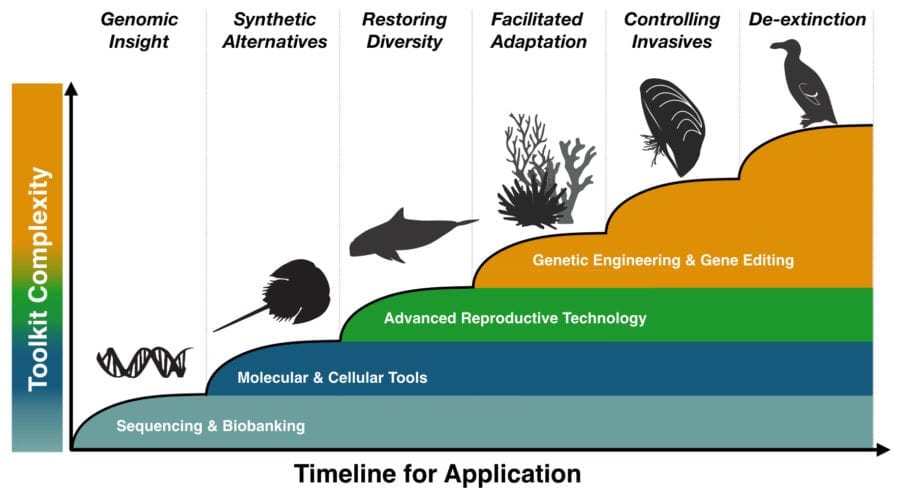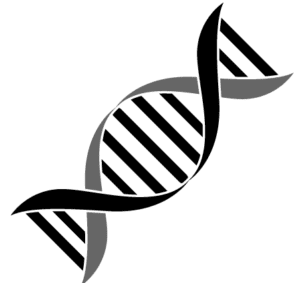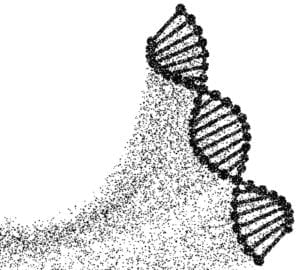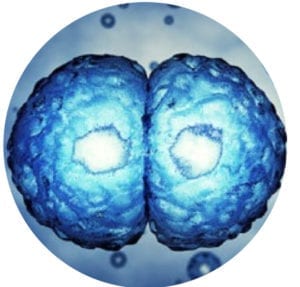GENETIC RESCUE TOOLKIT
Genetic Rescue: A New Toolkit for Conservation
Genetic rescue spans a continuum from “insight to intervention,” and can provide critical understanding of evolutionary processes that can better inform species conservation in a rapidly changing world. Genomics can document biodiversity, inform conventional management practices, and in some cases, enable genomic interventions. Genomic technology has the potential to advance and compliment conventional conservation management with precise genetic rescue.
The Genetic Rescue Toolkit
The tools of genetic rescue are adaptable and may be appropriate to address specific threats to marine ecosystems as well as provide powerful new monitoring insights. Different threats and ecological settings will likely be more amenable to intervention than others. Also, the extent to which different genomic tools will be appropriate, or even transformative, will vary across taxa and ecosystems. Factors for consideration include the nature of the conservation threat, the availability of genomic resources and technologies, the social and ethical implications of intervention, and the likelihood of success.
Most conservation focused genetic approaches have been limited to assessing very basic evolutionary processes such as gene flow, neutral genetic diversity, and effective population size, with little meaningful understanding of how genetic variation relates specifically to adaptation. Given the affordability of sequencing and the increasing prevalence of conservation threats potentially suited to genetic approaches, there is an opportunity to advance a suite of innovative new tools.
Biobanking & Sequencing
Preserving biodiversity through bio-banking is an important strategy to both document and preserve genetic diversity. Bio-banking is the collection and preservation of living and frozen samples of biological materials. Somatic and germ line cells can be cryopreserved and potentially used in research and cloning programs. A variety of tissue and cell types can be preserved through culture and cryogenic methods, and as advanced reproductive technologies develop, bio-banked cells may be used for direct interventions, such as augmenting diversity to rescue shrinking populations. However, cell culture techniques and reproductive technologies capable of harnessing these preserved tissues to rescue species requires significant laboratory expertise that can be highly taxon-specific and knowledge that is lacking for most oceanic species.
Read more
A growing number of organizations are growing collections of cryopreserved tissue and cell line samples, including the San Diego Frozen Zoo with over 1,000 taxa preserved, the American Museum of Natural History, the Frozen Ark, Northeastern University’s Ocean Genomics Legacy, and the for-profit company Cryogenetics (which has a special focus on commercial fisheries). Bio-banking should be a more common practice and coupled with any comprehensive and targeted sequencing initiatives.
There are many levels of genomic sequencing techniques that can be used for conservation purposes.
The field of genomics forms the foundation for genetic insight and intervention applications; however, any use of genomics research for conservation begins with one building block: a reference genome. While there are many genome initiatives, they have accumulated primarily the genomes of non-endangered species, hence there is a lack of available reference genomes for conservation purposes. Without high quality reference genomes, genetic studies for conservation are limited to older, much less informative sequencing techniques, and therefore have fewer conservation applications. A number of challenges need to be overcome to generate reference genomes for managed and threatened species, but with more sequencing, the full potential of genetic rescue innovations can be developed.
Environmental DNA (eDNA)
eDNA provides marine conservation with an extraordinary new tool to document life and diversity in the ocean. Simply by sampling the environment, researchers can rapidly assess species diversity in a variety of habitats, as well as document the presence of focal species. This is a potentially transformative development enhancing our ability to document marine biodiversity. In marine settings, rare or elusive species can be difficult and costly to monitor using conventional methods, challenging our ability to understand habitat requirements and estimate population size.
Read more
Metabarcoding approaches enable the characterization of entire ecological communities without prior knowledge of species likely to be present. This application of eDNA monitoring contributes a powerful genomic tool for conservation that will continue to improve as the technologies and bioinformatic abilities are developed. A large-scale program centered around cataloguing biodiversity in different habitats and locations can provide critical baseline information and identify critically imperiled habitats and may eventually allow for population level inferences of target taxa without the need for invasive or labor-intensive sampling. Notably, as invasive species expand into new marine environments, early detection can be difficult. eDNA enables a rapid assessment of the expanding presence of an invasive species which can greatly aid in controlling its spread
The level of resolution provided by eDNA data is contingent upon the quality of genomic data used to sort and allocate sequence identities. The application of eDNA monitoring to specific conservation goals will require genomic references for target species. Narrowing the focus of questions to be addressed with eDNA can decrease the references needed for an effective database and reduce the processing burden.
Localized populations or groups can be compared across the genome, transcriptome, and proteome to determine genetic basis of adaptation to local environments and responses to environmental stimuli. Such analyses can guide the formulation, execution, and monitoring of species management planning through enhanced understanding of adaptive and demographic processes related to landscapes- or “Landscape Genomics”.
These insights have been useful in guiding connectivity planning for fragmented populations, and identifying instances where populations have extremely low genetic diversity and require genetic rescue. These insights are also extremely important in conservation planning in response to climate change and for understanding organismal response to disease and stress. Collectively, genomics tools applied appropriately can uncover insights on populations with various levels of suitable adaptations providing an opportunity to manage populations with greater precision and intent. Such information can ultimately transform conservation practice from a “one size fits all” to more targeted restoration and management.
Synthetic Biology
Biotech and synthetic molecular biology can provide alternatives to harvesting wildlife for products in high demand. Alternatives include the “green agriculture” of wildlife food species, exemplified by AquaBounty’s development of genetically engineered Atlantic salmon (Salmo salar) . Also in development are synthesized bioproducts for plant-based seafood products that mimic the consumer experience of seafood (plant-based) or genuine seafood products manufactured through cell culture rather than from whole animals (clean seafood). These strategies present a great opportunity to address the ecological and economic crisis associated with current seafood production systems (both wild-caught and farmed) in a highly scalable and sustainable manner. Many over-exploited species are harvested for reasons other than direct human consumption, including biomedical applications. Synthetic alternatives for such products have been developed but not widely adopted demonstrating that social forces can contribute strongly to the adoption and widespread application of genomic and biotech intervention.
Advanced Reproductive Technologies
Advanced reproductive technologies are an important tool for genetic rescue. Increasingly, scientists are able to transfer genomic material from one species directly into a surrogate, enabling the production of individuals that otherwise could not be born. Such technologies promise to improve endangered species conservation outcomes, particularly when paired with gene-editing techniques, but will require substantial investment and planning for each target and species.
Read more
More conventional technologies include in vitro fertilization (IVF) and even somatic cell nuclear transfer (aka cloning), which require gametes (spermatozoa and oocytes) from the target species. Two newer methods exist in the absence of living oocyte donors for mammals: interspecies somatic cell nuclear transfer (iSCNT) and stem cell embryogenesis (SCE). iSCNT has been demonstrated to successfully produce surviving offspring of several wild felids (Gómez et al., 2009) and endangered gray wolves (Kim et al., 2007). There must be cellular and reproductive compatibility between the donor and surrogate species to generate viable embryos and pregnancies. Comparative genomics and epigenomics should be used to determine the best surrogate. The black-footed ferret is the subject of a restoration strategy centered around this technology (Wisely et al., 2015).
The revolutionary potential of SCE technology is that it can reduce the reproductive resources needed to yield offspring. A skin cell is first transformed into a stem cell (called an induced pluripotent stem cell, or iPSC). Once a stem cell, it can be reprogrammed to develop into sperm or egg cells. Once sperm and egg cells are made scientists can apply IVF to generate an embryo, implant the embryo into a surrogate mother, and give birth to a new unique individual. This process is currently being pioneered to save the Northern White Rhinoceros (Ceratotherium simum cottoni) from extinction. Currently, SCE has only been achieved in mice and stem cell technologies overall are most advanced in mammals.
iSCNT and SCE are not yet viable options for reproducing endangered birds. The only technology that allows the cryopreservation and reproduction of cells in birds is germline transfer/transmission (GTT) using primordial germ cells (PGCs), which was developed in 2006 (van de Lavoir et al. 2006). GTT requires the collection of cells from the target species. Like iSCNT, once donor cells are collected they can be transferred and transmitted through a surrogate species reproductive system. Research teams in 2012 transmitted domestic chicken PGCs through a male guinea fowl using this technique (van de Lavoir et al. 2012). While the technique of GTT could be universal for all birds, PGCs have only been successfully cultured for the domestic chicken, which currently prevents the technique from being applied for conservation of wild species.
The major complication for reproductive technologies is that every species’ reproductive biology is unique, even among very closely related species. Substantial investment in genomic resource generation, cell culture conditions, and gamete/embryonic transfer techniques is required as these must be adapted for surrogate and donor species. Additionally, such endeavors require extensive planning to specify short- and long-term goals, and ways by which success will be measured.
Genetic Engineering
Genomic “intervention,” in contrast to “insight,” involves the direct manipulation of individual organisms’ and populations’ genes or genetic variants to enhance population fitness and improve viability. Such manipulations include introducing/deleting beneficial/harmful genetic variation either through genome-editing techniques or the physical movement of individuals between populations, altering the reproductive success of particular species or variants, and harnessing gene editing and reproductive cloning technologies to rescue critically endangered species. Such approaches may rely upon advanced reproductive technologies, which are still poorly known for many taxa. Ultimately, genomic interventions will require not only sophisticated genomic engineering, but also stringent planning and program development that is based on engagement with a multitude of stakeholders and includes social and ethical considerations.
Gene Drive
Threshold independent gene drives can be used to spread genes through a population in a way that alters the standard model of inheritance (Burt 2003). Normally, releasing an organism with a single copy of a recessive-lethal gene (lethal when two copies present) will result in the gene’s dilution as it only gets passed on to half of the offspring per reproductive cycle. If two carriers mate, 25 percent of them will be non-viable homozygotes, 25 percent will not carry the gene and 50 percent will be heterozygotes. If the recessive lethal gene is part of a gene-drive system, all offspring receive a copy of the recessive gene and it can spread through all populations connected by gene-flow. Any mating between carriers results in 100 percent non-viable offspring.
Read more
Gene drive methods are in advanced development in mosquitos as a mechanism to combat malaria (Hammond et al. 2016) and testing is ongoing in rodents (Leitschuh et al. 2018). However, the technique is controversial due to the concerns over uncontrollable negative effects on ecosystems or from a release of gene drive to unintended areas. Other research outlines large technical hurdles facing gene drives, such as inbreeding, poor homing, and development of resistance mutations (Unckless et al. 2018). Overcoming these challenges will need to be coupled with development of gene-drive systems with population percentage thresholds and/or mechanisms for spatial/temporal control.











Back to Top